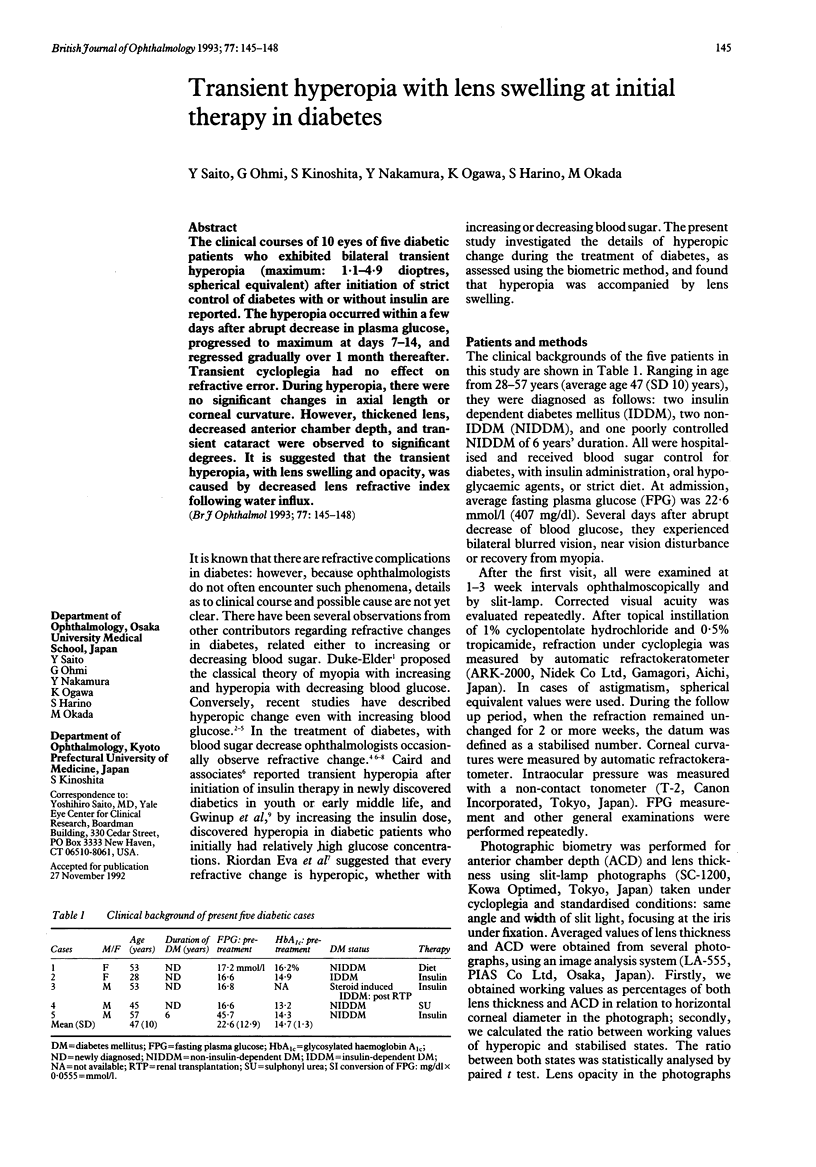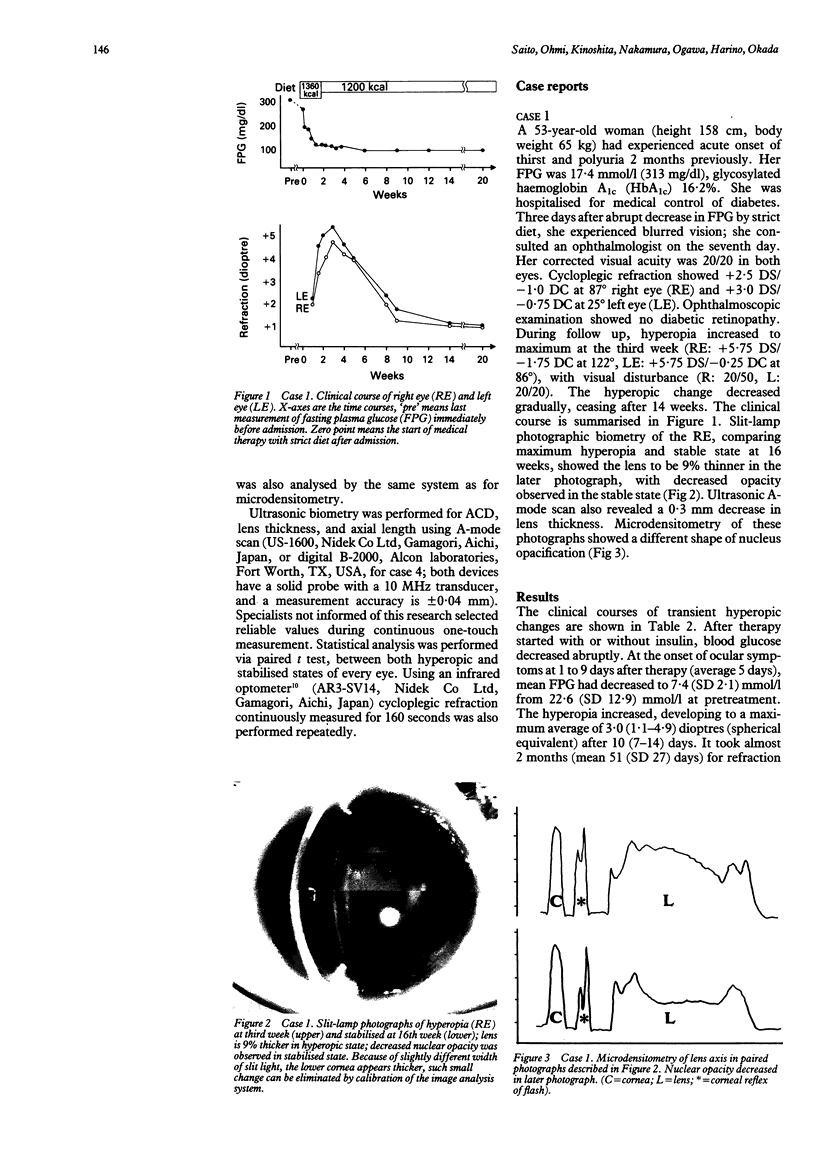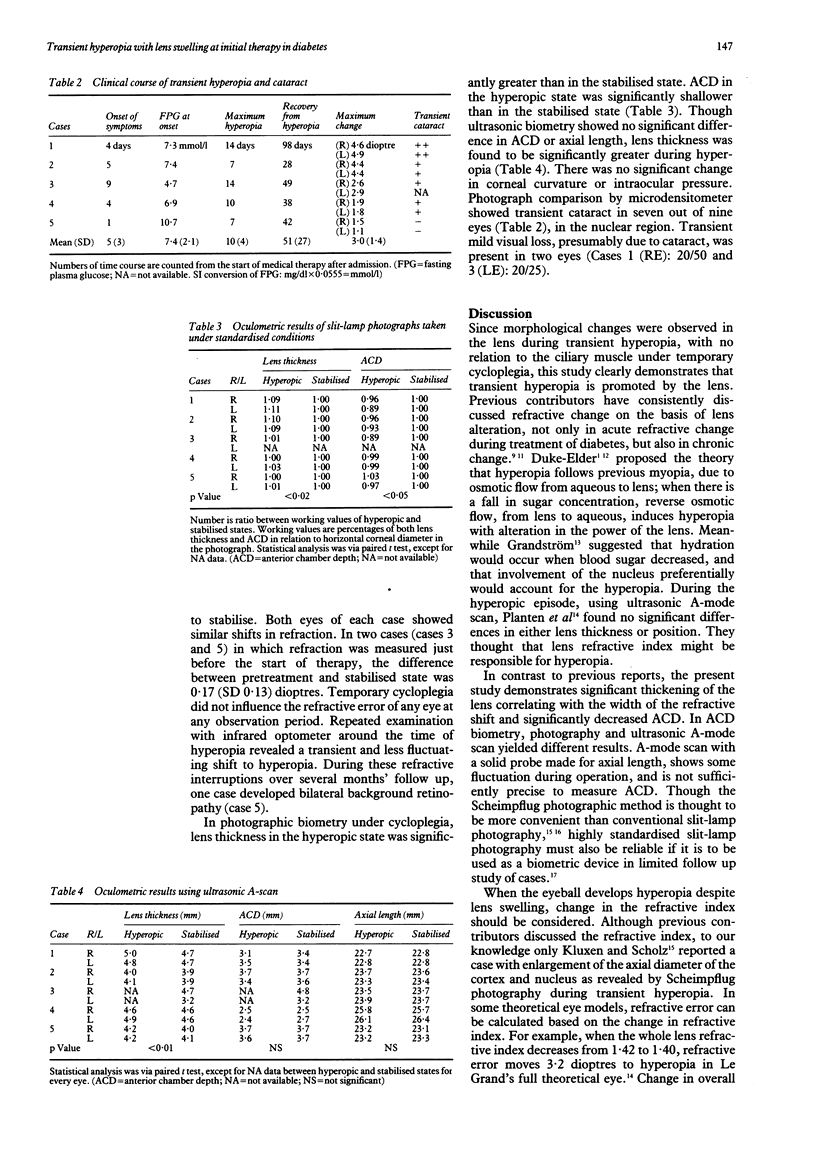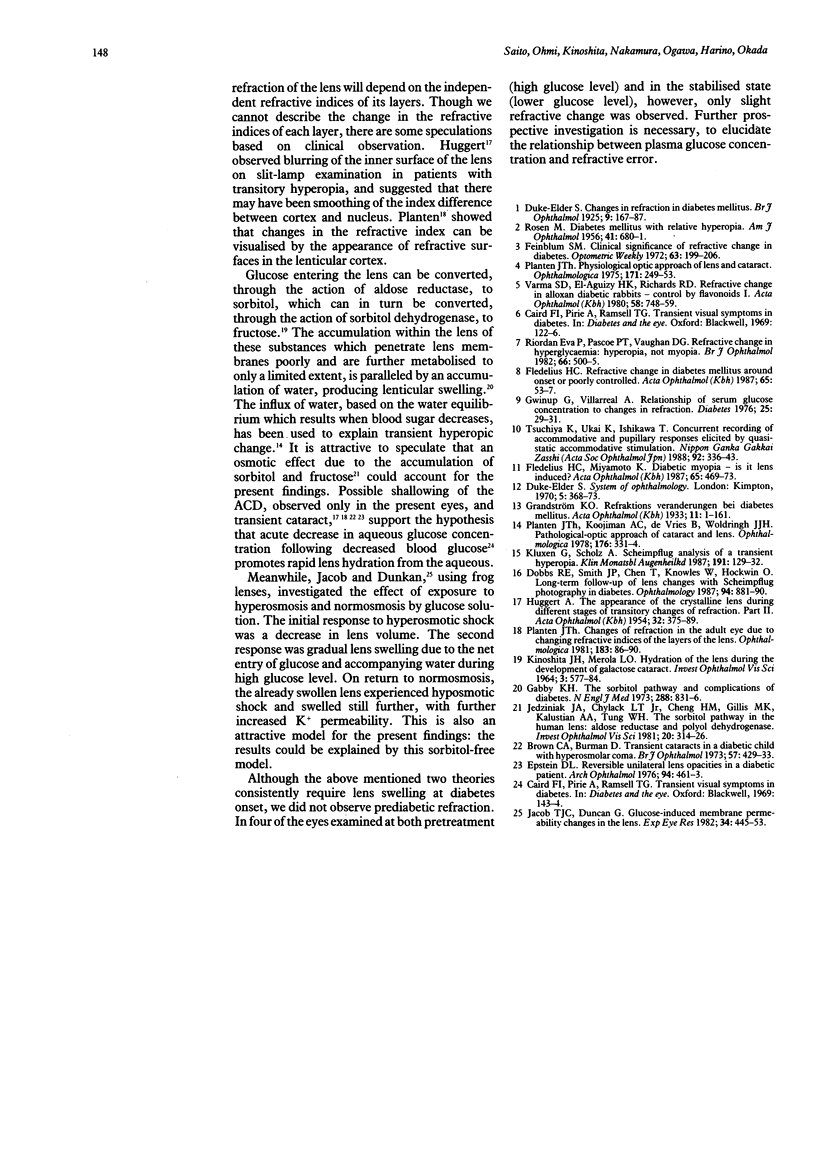Abstract
The clinical courses of 10 eyes of five diabetic patients who exhibited bilateral transient hyperopia (maximum: 1:1-4.9 dioptres, spherical equivalent) after initiation of strict control of diabetes with or without insulin are reported. The hyperopia occurred within a few days after abrupt decrease in plasma glucose, progressed to maximum at days 7-14, and regressed gradually over 1 month thereafter. Transient cycloplegia had no effect on refractive error. During hyperopia, there were no significant changes in axial length or corneal curvature. However, thickened lens, decreased anterior chamber depth, and transient cataract were observed to significant degrees. It is suggested that the transient hyperopia, with lens swelling and opacity, was caused by decreased lens refractive index following water influx.
Full text
PDF



Images in this article
Selected References
These references are in PubMed. This may not be the complete list of references from this article.
- Brown C. A., Burman D. Transient cataracts in a diabetic child with hyperosmolar coma. Br J Ophthalmol. 1973 Jun;57(6):429–433. doi: 10.1136/bjo.57.6.429. [DOI] [PMC free article] [PubMed] [Google Scholar]
- Dobbs R. E., Smith J. P., Chen T., Knowles W., Hockwin O. Long-term follow-up of lens changes with Scheimpflug photography in diabetics. Ophthalmology. 1987 Jul;94(7):881–890. doi: 10.1016/s0161-6420(87)33544-4. [DOI] [PubMed] [Google Scholar]
- Duke-Elder W. S. CHANGES IN REFRACTION IN DIABETES MELLITUS. Br J Ophthalmol. 1925 Apr;9(4):167–187. doi: 10.1136/bjo.9.4.167. [DOI] [PMC free article] [PubMed] [Google Scholar]
- Epstein D. L. Reversible unilateral lens opacities in a diabetic patient. Arch Ophthalmol. 1976 Mar;94(3):461–463. doi: 10.1001/archopht.1976.03910030231012. [DOI] [PubMed] [Google Scholar]
- Eva P. R., Pascoe P. T., Vaughan D. G. Refractive change in hyperglycaemia: hyperopia, not myopia. Br J Ophthalmol. 1982 Aug;66(8):500–505. doi: 10.1136/bjo.66.8.500. [DOI] [PMC free article] [PubMed] [Google Scholar]
- Fledelius H. C., Miyamoto K. Diabetic myopia--is it lens-induced? An oculometric study comprising ultrasound measurements. Acta Ophthalmol (Copenh) 1987 Aug;65(4):469–473. doi: 10.1111/j.1755-3768.1987.tb07025.x. [DOI] [PubMed] [Google Scholar]
- Fledelius H. C. Refractive change in diabetes mellitus around onset or when poorly controlled. A clinical study. Acta Ophthalmol (Copenh) 1987 Feb;65(1):53–57. doi: 10.1111/j.1755-3768.1987.tb08491.x. [DOI] [PubMed] [Google Scholar]
- Gabbay K. H. The sorbitol pathway and the complications of diabetes. N Engl J Med. 1973 Apr 19;288(16):831–836. doi: 10.1056/NEJM197304192881609. [DOI] [PubMed] [Google Scholar]
- Gwinup G., Villarreal A. Relationship of serum glucose concentration to changes in refraction. Diabetes. 1976 Jan;25(1):29–31. doi: 10.2337/diab.25.1.29. [DOI] [PubMed] [Google Scholar]
- HUGGERT A. The appearance of the crystalline lens during different stages of transitory changes of refraction. II. Acta Ophthalmol (Copenh) 1954;32(4):375–389. doi: 10.1111/j.1755-3768.1954.tb05057.x. [DOI] [PubMed] [Google Scholar]
- Jacob T. J., Duncan G. Glucose-induced membrane permeability changes in the lens. Exp Eye Res. 1982 Mar;34(3):445–453. doi: 10.1016/0014-4835(82)90090-2. [DOI] [PubMed] [Google Scholar]
- Jedziniak J. A., Chylack L. T., Jr, Cheng H. M., Gillis M. K., Kalustian A. A., Tung W. H. The sorbitol pathway in the human lens: aldose reductase and polyol dehydrogenase. Invest Ophthalmol Vis Sci. 1981 Mar;20(3):314–326. [PubMed] [Google Scholar]
- KINOSHITA J. H., MEROLA L. O. HYDRATION OF THE LENS DURING THE DEVELOPMENT OF GALACTOSE CATARACT. Invest Ophthalmol. 1964 Dec;3:577–584. [PubMed] [Google Scholar]
- Kluxen G., Scholz A. Auswertung von Scheimpflug-Photos bei einer transitorischen Hypermetropie. Klin Monbl Augenheilkd. 1987 Aug;191(2):129–132. doi: 10.1055/s-2008-1050481. [DOI] [PubMed] [Google Scholar]
- Planten J. T. Changes of refraction in the adult eye due to changing refractive indices of the layers of the lens. Ophthalmologica. 1981;183(2):86–90. doi: 10.1159/000309145. [DOI] [PubMed] [Google Scholar]
- Planten J. T., Kooijman A. C., de Vries B., Woldringh J. J. Pathological-optic approach of cataract and lens. Ophthalmologica. 1978;176(6):331–334. doi: 10.1159/000308724. [DOI] [PubMed] [Google Scholar]
- Planten J. T. Physiologic optic approach of lens and cataract. Ophthalmologica. 1975;171(4-5):249–253. doi: 10.1159/000307518. [DOI] [PubMed] [Google Scholar]
- ROSEN M. Diabetes mellitus with relative hyperopia; a case report. Am J Ophthalmol. 1956 Apr;41(4):680–681. doi: 10.1016/0002-9394(56)91667-1. [DOI] [PubMed] [Google Scholar]
- Tsuchiya K., Ukai K., Ishikawa S. [Concurrent recording of accommodative and pupillary responses elicited by quasi-static accommodative stimulation]. Nippon Ganka Gakkai Zasshi. 1988 Feb;92(2):336–343. [PubMed] [Google Scholar]
- Varma S. D., El-Aguizy H. K., Richards R. D. Refractive change in alloxan diabetic rabbits. Control by flavonoids I. Acta Ophthalmol (Copenh) 1980 Oct;58(5):748–759. doi: 10.1111/j.1755-3768.1980.tb06688.x. [DOI] [PubMed] [Google Scholar]



